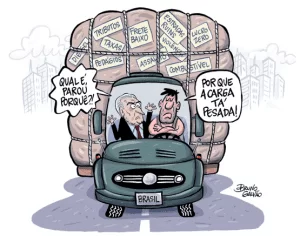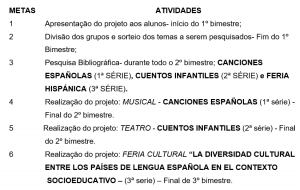ORIGINAL ARTICLE
MONKEN, Priscila Mattos [1]
MONKEN, Priscila Mattos. Unveiled Metaphors: Analysis in the language used by Murilo Mendes in Poesia e Liberdade. Revista Científica Multidisciplinar Núcleo do Conhecimento. Year 05, Ed. 12, Vol. 19, pp. 05-13. December 2020. ISSN: 2448-0959, Access link: https://www.nucleodoconhecimento.com.br/lyrics/unveiled-metaphors
SUMMARY
The study of this article is related to Semantics. Language reveals the idea of a social thought which forms a mental act. In this respect, we will study a stylistic resource called metaphor. In fact, since Aristotle’s Poetics and Rhetoric, it is written about this phenomenon, however it is still a challenge for many linguists who propose various explanations. We will reflect on the uses of this linguistic resource and later analyze it in the language used by Murilo Mendes in Poesia e Liberdade. Based on the assumption that metaphor is closely linked to language, we research the various metaphorical typologies, in order to observe why one use to the detriment of the other and the effect it causes. We intend to show how this linguistic instrument is linked to issues of social and ideological nature. To this end, we began our studies with a theoretical research that will be expanded with the advancement of the results we seek in order to better understand the contribution of metaphor to the interpretation not only of literary texts but also of the entire universe that surrounds us. In addition, the mechanisms of the language can be better instrumentalized from this article.
Keywords: Metaphor, language, Murilo Mendes.
1. INTRODUCTION
Metaphor is one of the most relevant categories of semantic change. Its historical roots begin in Classical Antiquity with Aristotle, also passing through the sieve of scholars from various areas, which give it well-differentiated status and functions.
As a significant resource, according to Stephen Ullmann (1961), in Semantics, it is found in several aspects: “as a primordial factor of motivation, as an expressive artifice, as a source of sininimy and polysemy”. This diversity of functions of the phenomenon associated with the plurality of points of view by which it is studied results in innumerable definitions that often do not fit. However, metaphor is not limited to literary language, but is closely linked to human language, or, more specifically, to the structuring of thought.
Researching metaphor in literary texts is what almost everyone does without saying, since any literary interpretation involves the unveiling of the text, its images and, consequently, its metaphors. Thus, we propose, in this work, to give a differentiated focus of everything that has been done lately. We intend to make, with the first objective of establishing an overview in the field of linguistic-literary studies, a survey of some concepts given to the term metaphor by theorists and scholars of the subject, to finally choose the vision of an author and from this perspective, then develop our studies.
The metaphor is notoriously present in our daily lives, but it is in language that it manifests itself more forcefully. Thus, all research will be permeated by the reflection of the language used by Murilo Mendes in Liberdade Poetry, assuming that metaphor is closely linked to language. We will deal with the various metaphorical typologies present in his texts, with the purpose of observing why one use to the detriment of the other and the effect it brings. It will also be shown how this linguistic resource is linked to social and ideological issues, through a survey and discussion of metaphorical expressions in the book Poesia Liberdade.
2. BIBLIOGRAPHIC REVIEW
2.1 DICTIONARY OF LINGUISTICS AND GRAMMAR, BY JOAQUIM MATTOSO CÂMARA JR
Metaphor is the figure of language that consists of transference (gr. metaphora) of a term for the scope of meaning that is not yours; unlike metonymy, it is not based on an objective relationship between one’s own and figurative meaning, but rather on an all subjective relationship, created in the mental work of apprehension; Ex.: ‘the last gold of the sun dies in the cerration’ (Bilac, Poesias, 340). The metaphor presents a very expressive function, since it highlights aspects that the term itself cannot evoke for itself; thus, the last sunlight would not highlight the special hue of sunlight at dusk. Therefore, metaphor is a common resource in language and essential in poetry (MURRY, 1951).
The metaphor is a fact of synchrony and only exists when the term has the meaning itself distinctly distinct from that of the term that is replaced. When it appears systematically in an expression such as idiocy, it loses the evocative force, because the term, in metaphorical principle, is languageally imposed on the expression (e.g., pin head); then there is a fossilization, and the metaphor only becomes evident in ad hoc formulations (e.g. they are ideas of a pinhead). In diachrony, metaphors enter semantic evolution and the term incorporates meaning, of metaphorical beginning, in the meaning itself, whose polysemy – a) Increases, or – b) Na, according to the ancient meaning itself – a) It remains, or – b) it goes away (e.g.: a) Saw for ‘set of mountains’ and for ‘tool’; B) Scourge (cf. lat. flagellum ‘chicote’d). (CÂMARA, 1992: 166).
2.2 DICTIONARY OF LITERARY TERMS, BY MASSAUD MOSES
The metaphor is mounted around a comparison, explicit or implicit; it consists, then, in the comparison between two words or phrases, resulting in the transformation of meaning of each member and the birth of an innovative meaning, resulting from the totality of the utterance. (MOISÉS, 1999)
“The analyses and interpretations on the subject allow us to believe that the metaphor is not exclusive to literary language.” It also occurs in spoken language, perhaps as abundantly as in literary texts. The difference would reside in the character assumed by the vulgar metaphor, everyday, and the metaphor used with aesthetic objectives. I am sure that verbal exchanges between people in daily social trade can be structured around aesthetically new or harmonic metaphors, but this is not the general trend. As a rule, spoken language uses what is called dead or latent metaphors, that is, petrified, stereotyped metaphors, made clichés, empty of meaning. Thus, for example, when saying ‘chair arm’, one is using a stereotyped metaphor, different from this other: ‘Your silence is a nau like all panda candles’ (Fernando Pessoa), of clear aesthetic cutout.
2.3 POETIC AND RHETORIC, BY ARISTOTLE
As already said,
the first observations about the concept of metaphor are due to Aristotle: ‘the metaphor consists in transporting to one thing the name of another, or genus for the species, or of the species for the genus, or of the species of one to the species of another, or by analogy’ (Poetics, tr. From Eudoro de Sousa, s.d., 1457 b 6). Aristotle returned to the subject in book III of Rhetoric, especially in the early chapters, where, with regard to the style appropriate to oratory art, he seeks to emphasize the function of metaphor: ‘there is no one who in the current conversation does not use metaphor’; ‘metaphor is the medium that most contributed to give thought clarity, pleased’; ‘metaphors should not be taken from afar, but of objects belonging to a nearby genus or similar species, so that it gives a name to what did not have it until then and it can be seen clearly that the designated object belongs to the same genus’; ‘metaphors are veiled puzzles’; ‘it is necessary that the metaphor be taken from the analogy, that it applies to both terms and comes from objects belonging to the same genre’ (tr. By Antônio Pinto de Carvalho, s.d., p. 209, 211 and 217)” (MOISÉS, 1999, p. 326-327).
2.4 COMMUNICATION IN MODERN PROSE, OTHON M. GARCIA
The motivations of the metaphor are composed under the similarities present in the objective world and the ineptitude of absolute abstraction, as well as on the relative poverty of vocabulary the disposition, given the richness and numerosity of the words and ideas to be transmitted and the aesthetic pleasure of the picturesque characterization.
In summary, the metaphor can be defined as the figure of meaning (trope) that consists in the affirmation of one thing (A) being the other (B), due to any similarity perceived by the essence between a characteristic trait of A and the predominant attribute, attribute par excellence, of B, in order to exclude the other secondary since they are not convenient to the characterization of the term itself (A). Thus, as an example, it is understood that when it comes to the emerald gemstone, the predominant attribute is its green color, of very particular brightness. Then, eyes with this same shade would allow the association by similarity, from which the metaphor would result: his eyes (A) are two emeralds (B). If the two terms – the compared (thing A) and the comparator (thing B) – are expressed, as in the previous examples, it is said that it is metaphor in praesentia; if only the comparating term is explicit, it is a metaphor in absentia (or pure, as it is also said): two emeralds shimmered in his face.
From a formal perspective, the metaphor is essentially an implicit comparison, that is, exonerated of comparative connective particles (such as, as, as, as), as well as not presenting a structure composed of verbs to seem, semelhar, to resemble suggesting, to give the impression of or an equivalent of these (GARCIA, 1983).
2.5 SEMANTICS, BY STEPHEN ULLMANN
According to Ullmann (1961), the basic structure of metaphor is very simple. “There are always two present terms: the thing we talk about and what we’re comparing it with.” The thing we talked about would be the content, what we’re comparing it with would be the vehicle. For the aforementioned author, the trait or traits they have in common would be called the “foundation of metaphor”
2.6 THE LIVING METAPHOR, BY PAUL RICOEUR
The living metaphor is an investigation into the creativity of language and its ability to focus on reality. In this work, Paul Ricoeur innovates senses for his “semantic impertinence”. Faced with the usual reference of a term, the metaphor generates a new reference, and in the face of the literal sense, a new semantic pertinence, which becomes “impertinent” with respect to the literal meaning. For him, poetic language is not only an “other way” of saying, but is a way of “saying more”, because there is an “added value” of meaning generated by the semantic work of metaphor (RICOEUR, 1975).
2.7 MODERN PORTUGUESE GRAMMAR, BY EVANILDO BECHARA
Bechara (2002) says that among the causes that motivate the change of meaning of words, one of the main ones is the metaphor that consists of the translation of meaning caused by employment in solidarity, in which the implied terms are part of different classes, being considered, however, by the combination, as assimilated. Giving as an example:
Snow hair, weigh the reasons, black foreboding, sweet dreams, religious steps […], stomach mouth, fork teeth, chair back, sofa arms, table feet, spending rivers of money, valley of tears, the sun of freedom, the days run, the night fell (BECHARA, 2002).
Thus, the metaphor does not come from an abbreviated comparison, as if it is traditionally considered; on the contrary, it is the comparison that consists of an explicit metaphor. It is also important that the linguistic metaphor (linguistically originated by the miscompass of the terms implied in solidarity) be distinguished from metaphor motivated extralinguistically by our knowledge about things, as occurs in metaphorical expressions of the kind not put the wagon before the oxen, in order to express oneself the incorrect anastrophis of an action or judgment. Metaphors are widely used in spontaneous language and literature, with a diffusion among symbolist poets (BECHARA, 2002).
2.8 NORMATIVE GRAMMAR OF THE PORTUGUESE LANGUAGE, BY ROCHA LIMA
Metaphor consists of the transposition of distinct meanings on a given term, due to an implicit comparison. It is established in a relationship of similarity, based on the most natural of psychological laws: the association of ideas. In which it also addresses several modalities, among which it is worth mentioning the embodiment, hyperbole, symbol and sinesthesia. (ROCHA LIMA, 1999).
3. PARTIAL CONCLUSIONS
We believe that Murilo Mendes’ text is full of metaphorical typologies and that identifying and contextualizing them, we will observe that metaphors are not limited in the political-social ideological space and so such metaphors would surpass this space, constituting themselves as metaphors of the always.
We realize that metaphor is not simply a comparative process, whether implicit, explicit, but a mental process that is the basis of communication, language and human thought.
We know that, following the Aristotelian line, is the great part of the work on the subject. Mattoso Câmara Jr., for example, in its Dictionary of linguistics and grammar, defines metaphor as the figure of language that transfers a term to a field of meanings that is not his own (CÂMARA, 1992). There are also many who, like the Greek thinker, associate the metaphorical phenomenon with comparison. This conceptualization seems to us somewhat simplistic, because it limits the phenomenon to vocabulary exchanges. We believe that with our later studies we will show that, although metaphor is a translation of meaning derived from an association by similarity, its occurrence is not limited to transferring meaning from one word to another. As Othon M. Garcia describes it, in his Communication in modern prose, the metaphor is based on saying that one thing (A) is another (B), when any similarity is perceived between some characteristic trait of A and the predominant characteristic of B (attribute par excellence), in order to exclude all other secondary aspects, since they are not convenient to the characterization of the proper term A (GARCIA, 1983).
4. BIBLIOGRAPHICAL REFERENCES
BECHARA, Evanildo. Moderna gramática da língua portuguesa. Rio de Janeiro: Lucerna, 2002.
GARCIA, Othon, M. Comunicação em prosa moderna. 11. ed. Rio de Janeiro: FGV, 1983.
METÁFORA. Em: CÂMARA JR., J. Mattoso. Dicionário de linguística e gramática. 16. ed., Petrópolis, Vozes, 1992.
METÁFORA. Em: MOISÉS, Massaud. Dicionário de Termos literários. 14. ed. São Paulo: Cultrix, 1999.
METÁFORA. In: Dicionário Michaelis Eletrônico. Versão para assinantes UOL.
RICOEUR, Paul. (1975) La Métaphore Vive. Paris: Éditions du Seuil. Ed. Ut.: Ricoeur, P. (1983). A Metáfora Viva. Tradução. Porto: Rés Editora.
ROCHA LIMA, Carlos Henrique da. Gramática normativa da língua portuguesa. Rio de Janeiro: José Olympio, 1999.
ULLMANN, Stephen. Semântica: Uma introdução à ciência do significado. Lisboa: Fundação Calouste Gulbenkian, 1961.
[1] Master’s degree in Cognition and Language. Specialization in Text Review. Graduation in Letters Portuguese.
Submitted: December, 2020.
Approved: December, 2020.





